The foreign troops are leaving Afghanistan after twenty years of war. The US President surprised many by bringing forward the end of operation to August 31; he however, excluded nearly 650 troops for offering security for the US embassy in Kabul. Earlier in his April 13 announcement, President Biden had stated that all the troops will be pulled out of Afghanistan by the twentieth anniversary of 9/11. Recent developments in Afghanistan indicate, a resurgent Taliban is quickly filling the power vacuum that is being left behind due to pulling out of foreign troops.
Taliban fighters have made swift gains in the past few months and claim to have seized control of about 85 per cent of territory in Afghanistan.1 Reportedly, they control 250 of Afghanistan’s 398 districts and are fighting to control many more; a claim the Afghan government has dismissed.2 Presently, there is no concrete way to verify these claims, as many areas have been changing hands back and forth between the Taliban and the Afghan forces, but there is hardly any doubt that the areas under the control of Taliban has increased substantially since the US announcement to withdraw its remaining troops from Afghanistan a couple of months earlier.
Although Biden admitted that the Taliban group is at its strongest point, he was unwilling to accept that the insurgent group might be in a position to take control of the country since the Afghan military is better equipped, trained and much greater in number. The situation on the ground however depicts a contradictory picture. Across the country districts are falling to the Taliban like dominos and they are in the process of acquiring control of the regional capitals. The first provincial capital to fall to the Taliban was Qala-e-Naw in Baghdis province in northern western Afghanistan bordering Turkmenistan, but later reports claimed that airstrikes were used and Special Forces were deployed to push back the fighters. 3 If media reports are to be believed, in northern Afghanistan, the Taliban has taken control of over 42 districts up to the end of June, including an important district in Kunduz province, which allows them to encircle the provincial capital.4
An interesting aspect of the Taliban resurgence in Afghanistan this time is its remarkable gain of territories in the northern part of Afghanistan. Even at the pinnacle of the Taliban’s power from 1996 to 2001, the Taliban could not make many inroads in northern, western and central Afghanistan. These regions were strongholds of Afghanistan’s ethnic minority groups and could not be brought under the control of predominantly ethnic Pashtun Taliban- which has its strong support base in the Pashtun majority Southern and Eastern provinces of Afghanistan. In June, the Taliban delivered a huge blow to the government when they seized Afghanistan’s main border crossing with Tajikistan- Shir Khan Bandar and then captured the town and all the border check posts with Tajikistan in northern Afghanistan.5 Over 1000 Afghan soldiers fled into neighbouring Tajikistan to escape clashes with the Taliban who mounted aggressive attacks on the Afghan forces a few days back.6
Mapping the Taliban Advancement in Afghanistan
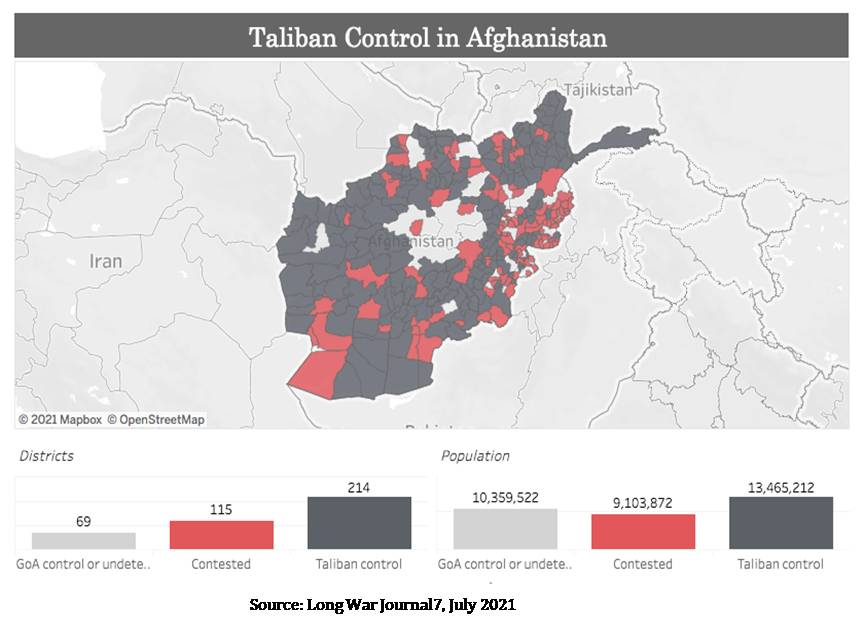
The recent trends indicate that the Taliban was first aiming for the control of territories where potential resistance could form against them. Moreover, these are provinces that provide a significant number of soldiers to the Afghan National Defense and Security Forces (ANDSF), therefore control over these regions also provide the Taliban an upper hand in the battlefield by denying recruitment to the ANDSF. In terms of symbolism, the gaining of Taliban control in the northern provinces is extremely significant- these are home to Northern Alliance leaders, most prominent being the legendary Tajik Commander Ahmed Shah Massoud. They not only stopped the Taliban advances in these regions in the 1990s when Massoud was alive, the Northern Alliance leaders played a key role in helping the Americans topple the Taliban.
Meanwhile, heavy fighting and contestation between the Afghan army and the Taliban were reported all across Afghanistan, especially in Kandahar, Baghlan, Ghazni, Takhar and Kunduz provinces since last week. The Taliban reportedly entered Kandahar city after capturing key districts surrounding it. They seized houses in Kandahar’s seventh police district, triggering fierce contestation between two sides. The Indian consulate in Kandahar had to be evacuated and reportedly some 50 diplomats and security personnel were flown back to New Delhi due to the deteriorating situation in Kandahar.8 According to media reports, the Taliban are advancing in rural areas and near Kabul. They now hold almost twice as much of Afghanistan as they did just two months ago, raising fresh doubts about whether the Afghan government can survive once US forces depart in two months.9
Early this month, the US left the Bagram Airbase- which was a key US base in Afghanistan; in the middle of the night without informing the local authorities. Hours after the US departure, the base was attacked by the Taliban who smashed barriers and ransacked the abandoned buildings, later however the Afghan forces were able to take control of the base.10 At a time when coordination and cooperation between the government forces and the withdrawing forces are extremely crucial, the Bagram airbase incident indicated the lack of the same.
With the Taliban increasingly gaining control over territories, Kabul launched the “National Mobilization” campaign to provide arms and ammunition to civilian volunteers so that they can resist the Taliban attackers. This strategy has been criticized by some analysts who think that the Afghan government might find it difficult to control them later. Austin Millar, the Commander of the US Mission in Afghanistan also expressed his scepticism towards this approach and cautioned that the militias deployed to help the Afghan security forces might lead the country into civil war. There is also a growing talk in Afghanistan, especially in the northern and western provinces about “second national resistance” against the Taliban. According to a report11 , powerful figures are mobilizing guerrilla forces which are re-arming themselves to take on the Taliban – “many of these strongmen have been part of the establishment and political order of post 9/11 Afghanistan. Many of them also believe that the Taliban only understand the language of power and that it is time for Afghans to unite against the group.”
The current scenario in Afghanistan has left many Afghans worried about their future and many of them are determined to leave the country. Thousands of Afghans have been gathering in the passport office in Kabul trying to find a way out. Many embassys have registered a dramatic increase in the number of Visa and Passport applications. In the past two decades, Afghanistan witnessed an emergence of a professional class of men and women especially in the urban centres; they are currently weighing the danger of the Taliban takeover of Afghanistan and an uncertain future ahead. Over the past couple of months, thousands of people were displaced from their homes in rural Afghanistan and they sought refuge in urban centres. With the provincial capitals being attacked, many Afghans would be forced to cross the border in search of safety.
There are reports that the regions that are taken over by the Taliban, they have imposed restrictions that replicate the approach of the Taliban adopted in the 1990s, when they were in power. Recent developments have convinced Afghans that the hard-won progress made in the past years are about to roll back, as a result, they are trying to flee the country. If Afghanistan continues on the trajectory it is on, civil war is certainly a path and that means the world should be prepared for a new wave of Afghan refugees at their doorsteps. The current situation in Afghanistan is a concern for the world at large but more so for its neighbours.
(The paper is the author’s individual scholastic articulation. The author certifies that the article/paper is original in content, unpublished and it has not been submitted for publication/web upload elsewhere, and that the facts and figures quoted are duly referenced, as needed, and are believed to be correct). (The paper does not necessarily represent the organisational stance... More >>
Endnotes
- “Taliban claim to control 85% of Afghanistan.”The Hindu,July 10, 2021. Available at: https://www.thehindu.com/news/international/taliban-claim-to-control-85-of-afghanistan/article35240241.ece (Accessed on July11, 2021)
- Ibid.
- “Taliban fighters storm capital of northwestern Afghan province”.Reuters, July 7, 2021. Available at: https://www.reuters.com/world/asia-pacific/taliban-attack-capital-northwestern-afghan-province-2021-07-07/(Accessed on July 11, 2021)
- Ibid
- “Taliban captures Afghanistan’s main Tajikistan border crossing”. AL Jazeera, 22 June 2021. Available at: https://www.aljazeera.com/news/2021/6/22/taliban-capture-afghanistans-main-tajikistan-border-crossing. (Accessed on July 11, 2021)
- “More than 1,000 Afghan soldiers flee into Tajikistan as Taliban extends control, Tajik officials say”.The Washington Post, July 6, 2021. Available at: https://www.washingtonpost.com/world/2021/07/05/afghan-soldiers-flee-tajikistan-taliban/(Accessed on July 11, 2021)
- Bill Rojjio, “Mapping the Taliban Controlled and Contested districts in Afghanistan”,FDD’s Long War Journal, June 23, 2021. Available at: https://www.longwarjournal.org/mapping-taliban-control-in-afghanistan(Accessed on July 12, 2021)
- RezaulLaskar, “Indian diplomats, security personnel evacuated as fighting escalates in Kandahar”, The HindustanTimes, July 11, 2021. Available at: https://www.hindustantimes.com/india-news/india-evacuates-diplomats-security-personnel-from-kandahar-as-fighting-escalates-101625967156486.html (Accessed on July 12, 2021)
- ,”Even the Taliban are surprised at how fast they are advancing in Afghanistan”, Op.cit. (Accessed on July 1, 2021)
- “US left Bagram Airbase at night with no notice, Afghan commander says”. BBC News,July 6, 2021. Available at: https://www.bbc.com/news/world-asia-57682290 (Accessed on July 12, 2021)
- Tamim Asey” Resistance 2.0- A military framework to deter a Taliban military takeover and engage the United States and the region on counter-terrorism and peace for Afghanistan”.The Atlantic Council, June 10, 2021.Availavle at: https://www.atlanticcouncil.org/blogs/southasiasource/resistance-2-0-a-military-framework/(Accessed on July 12, 2021)
Image Source: https://images.financialexpress.com/2021/07/taliban.jpg

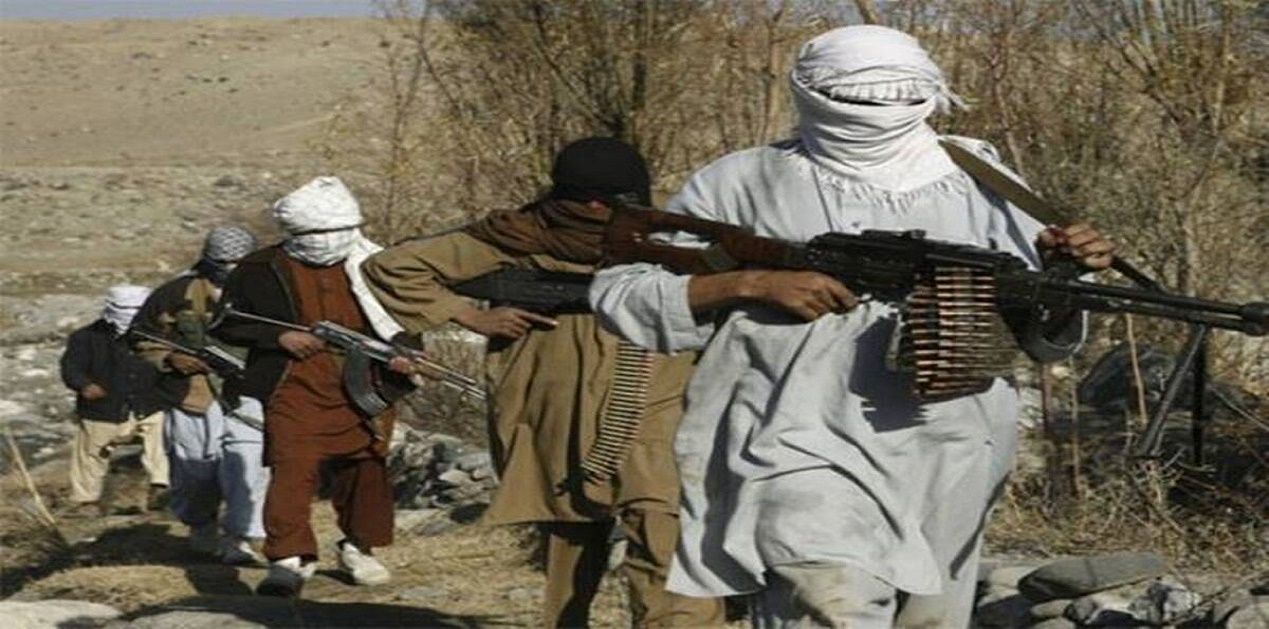


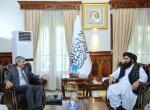
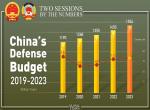
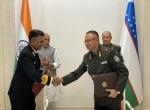
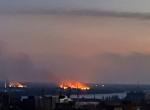

Post new comment